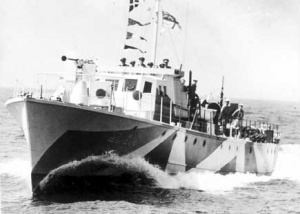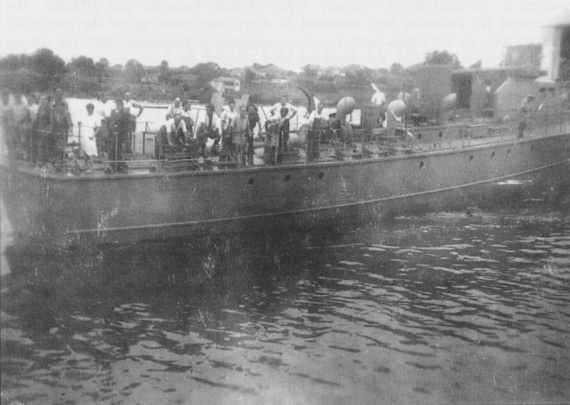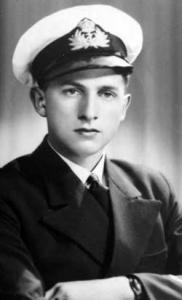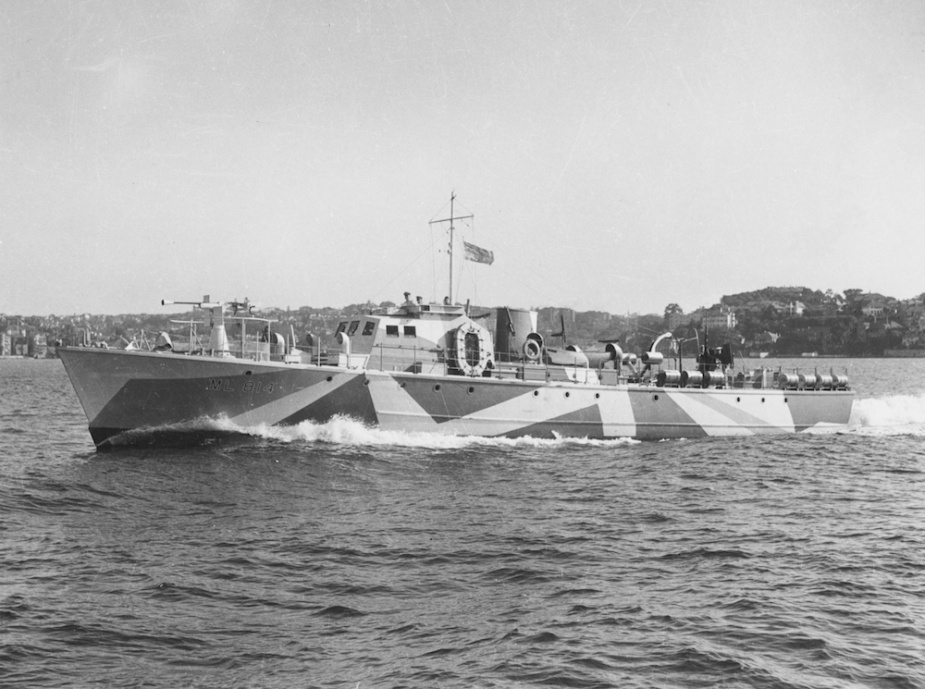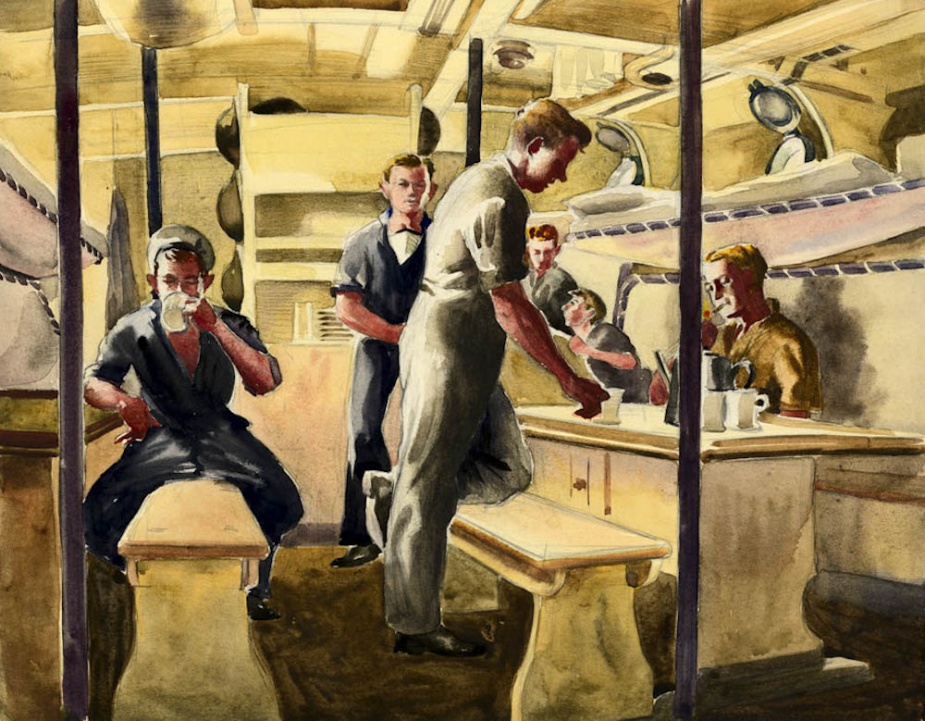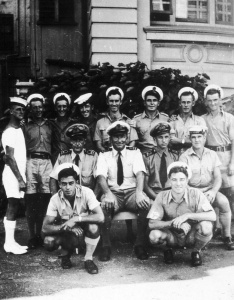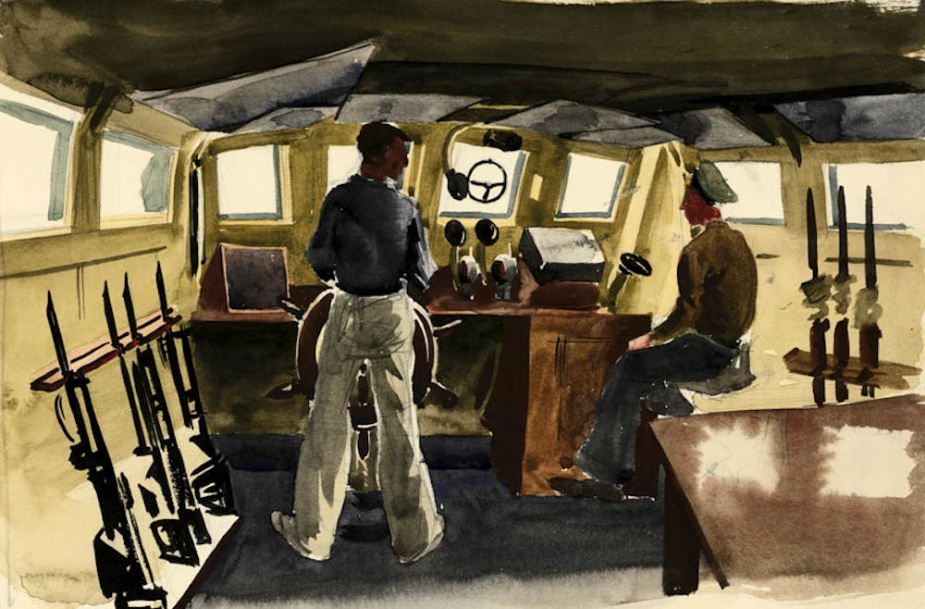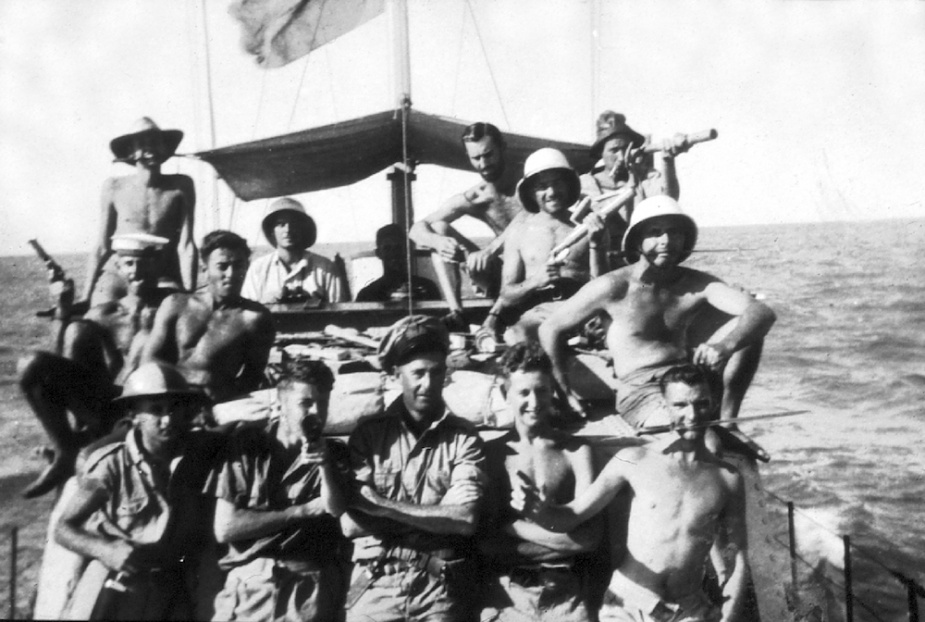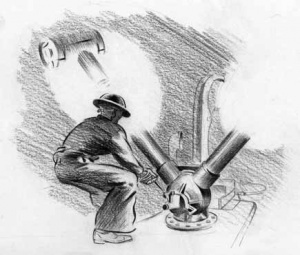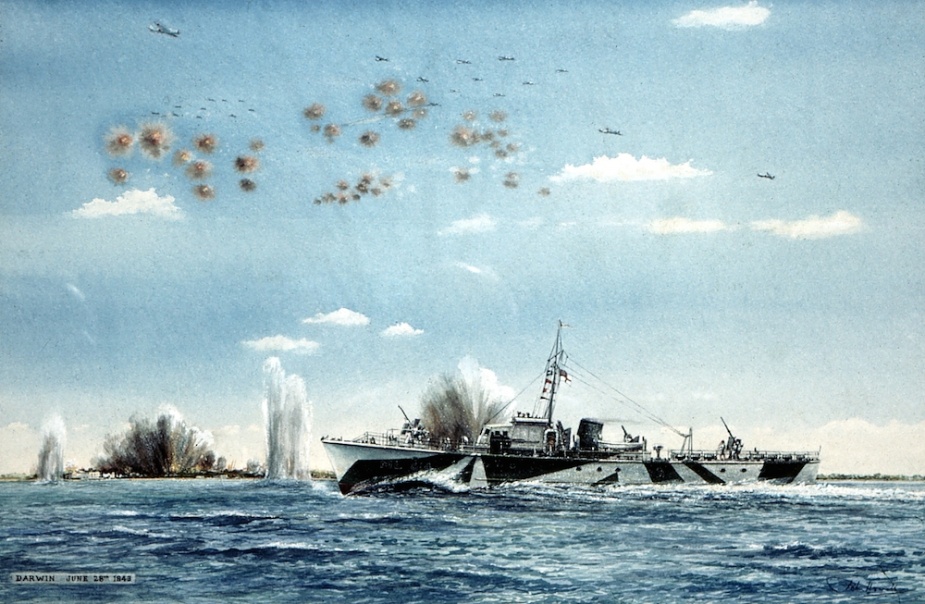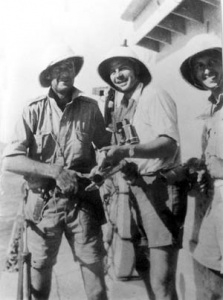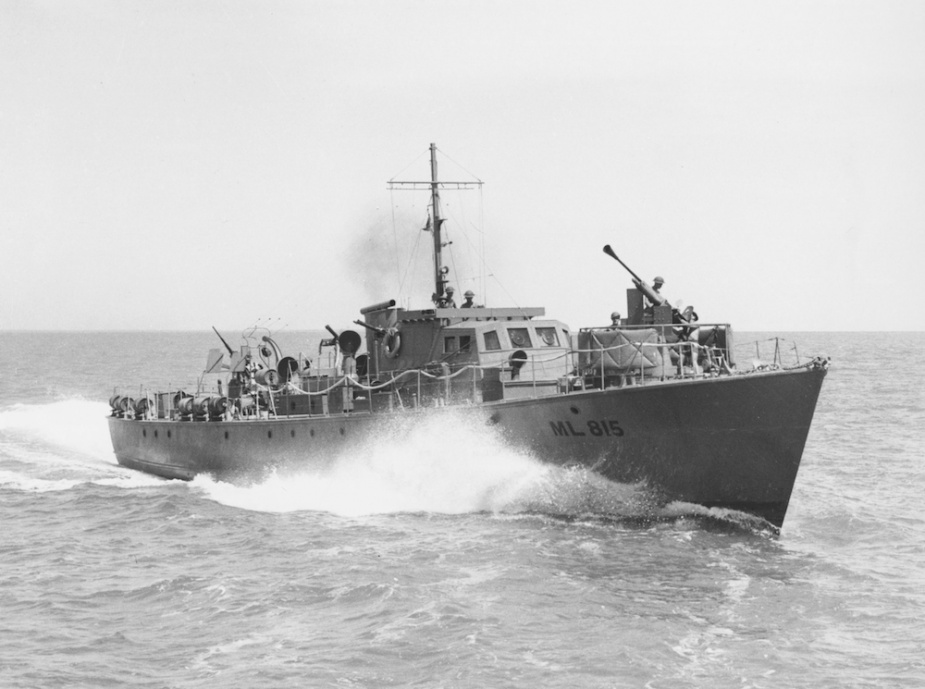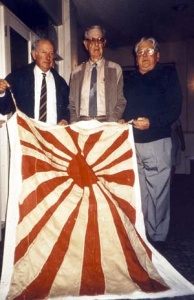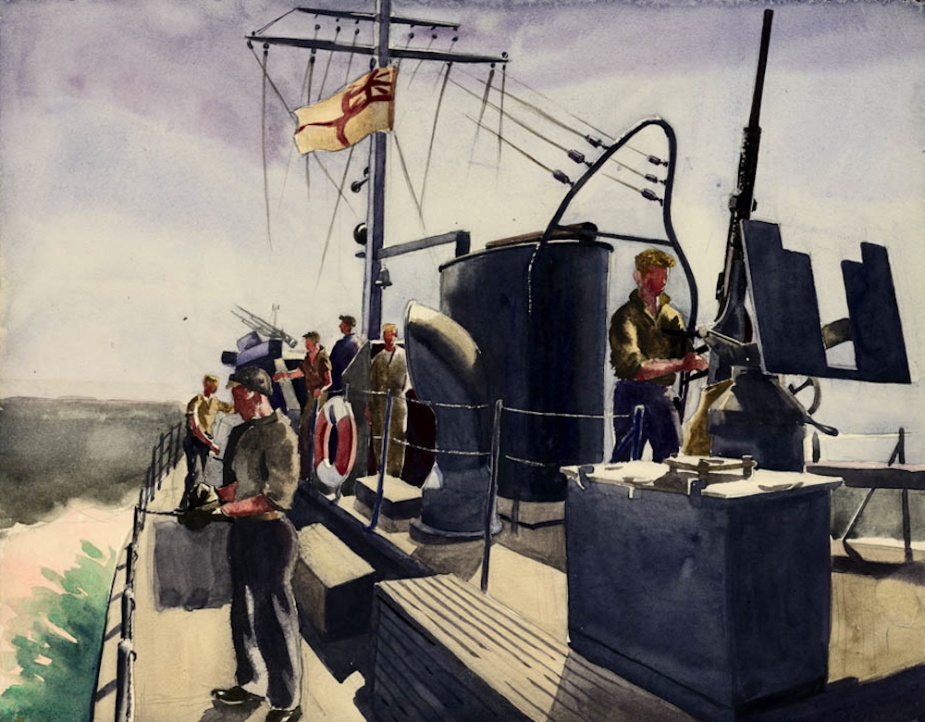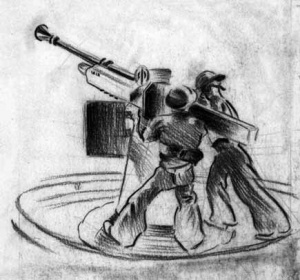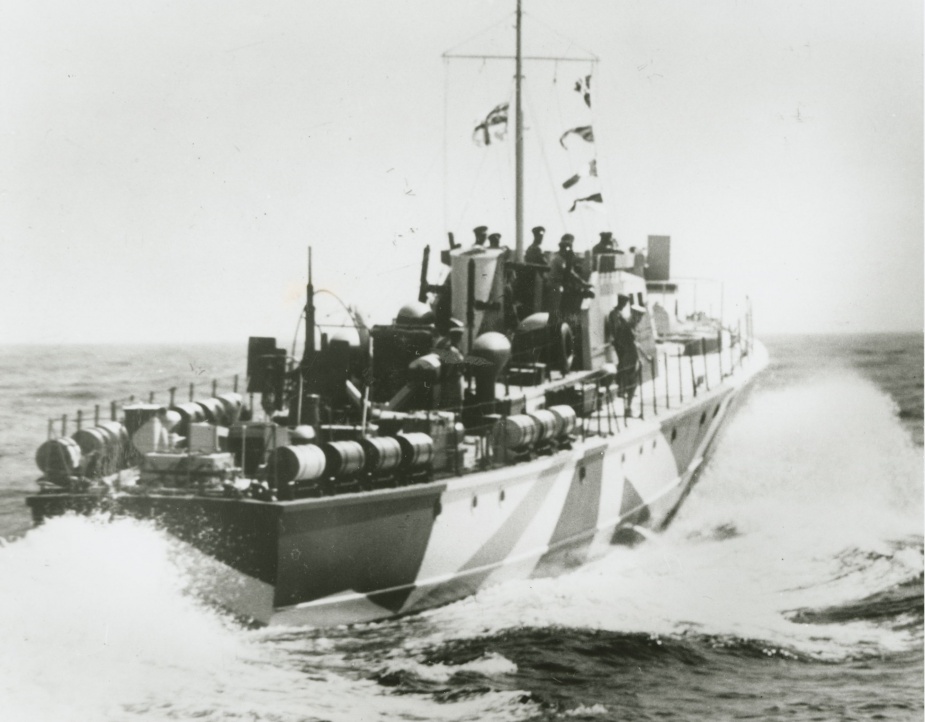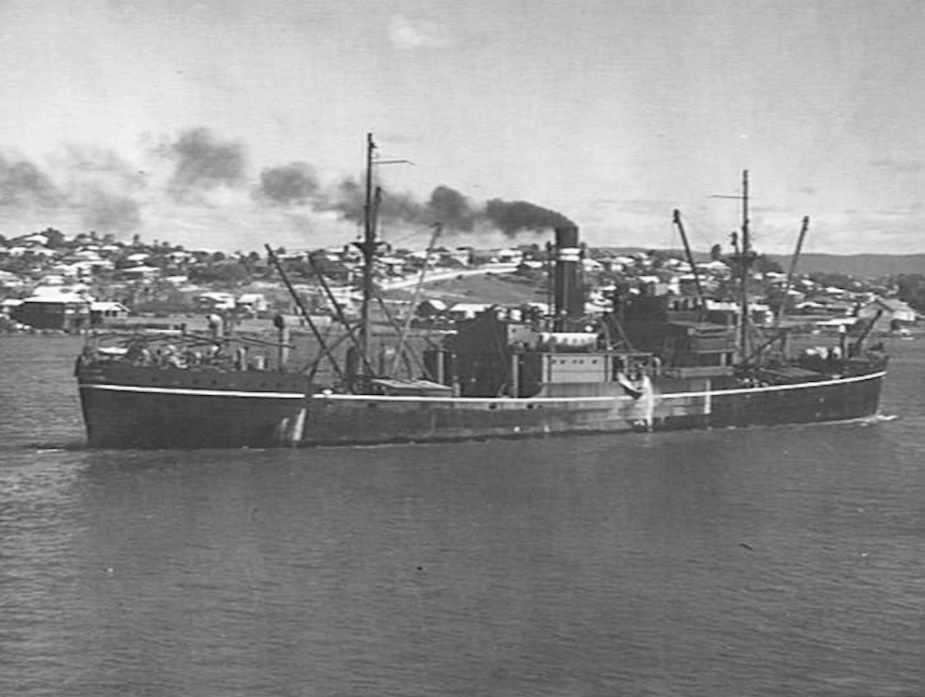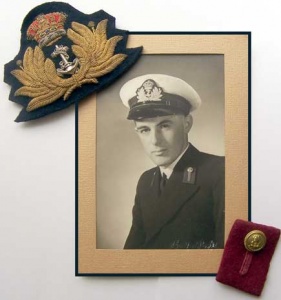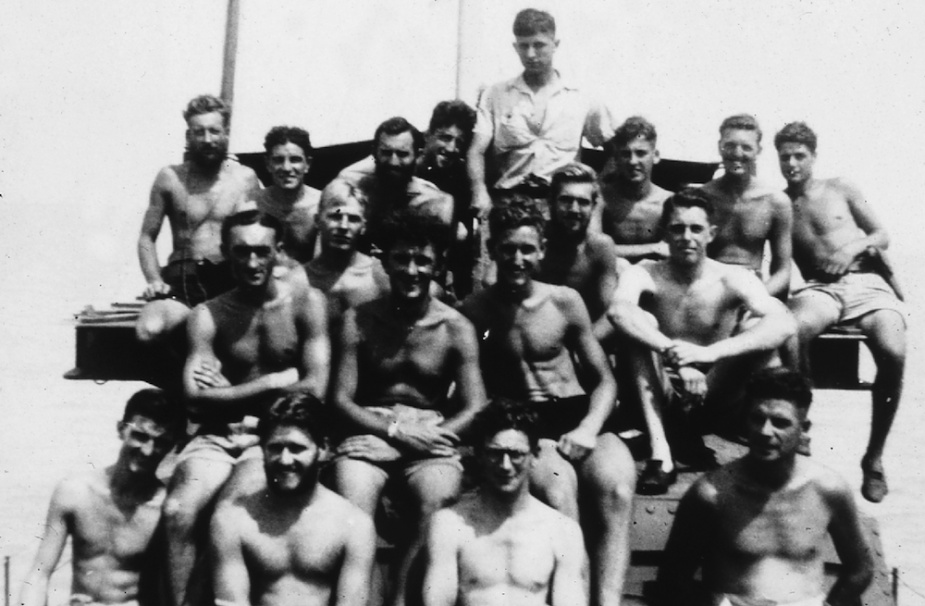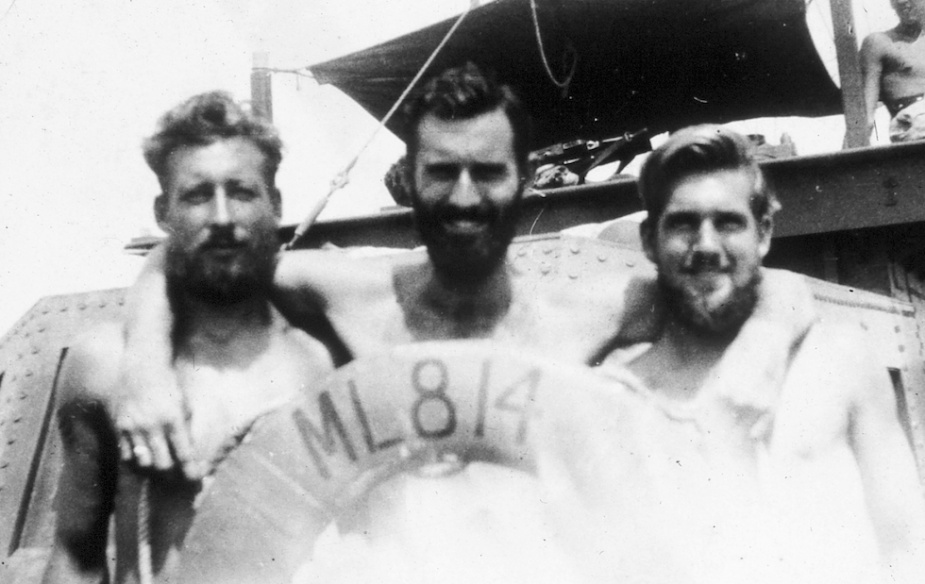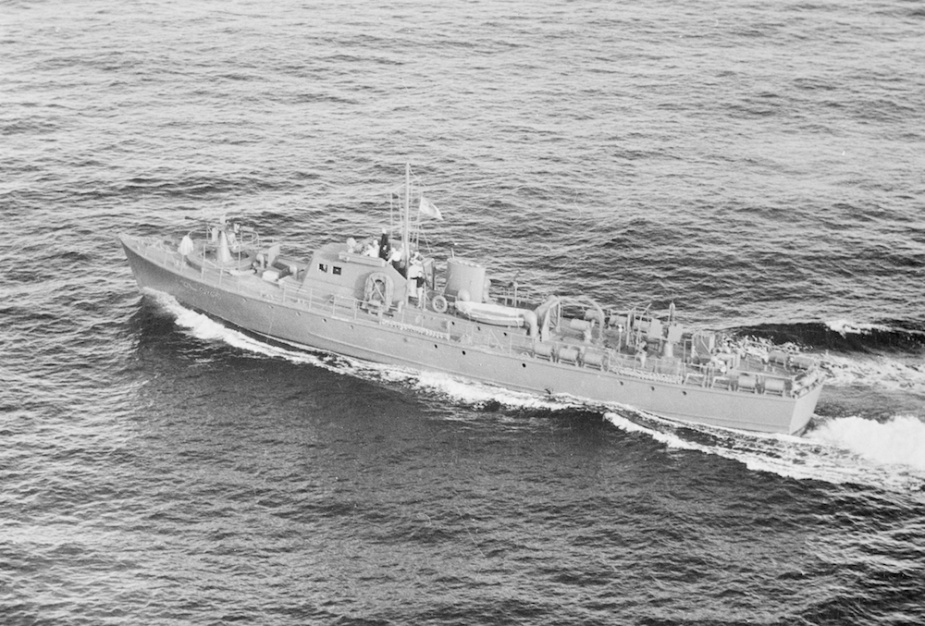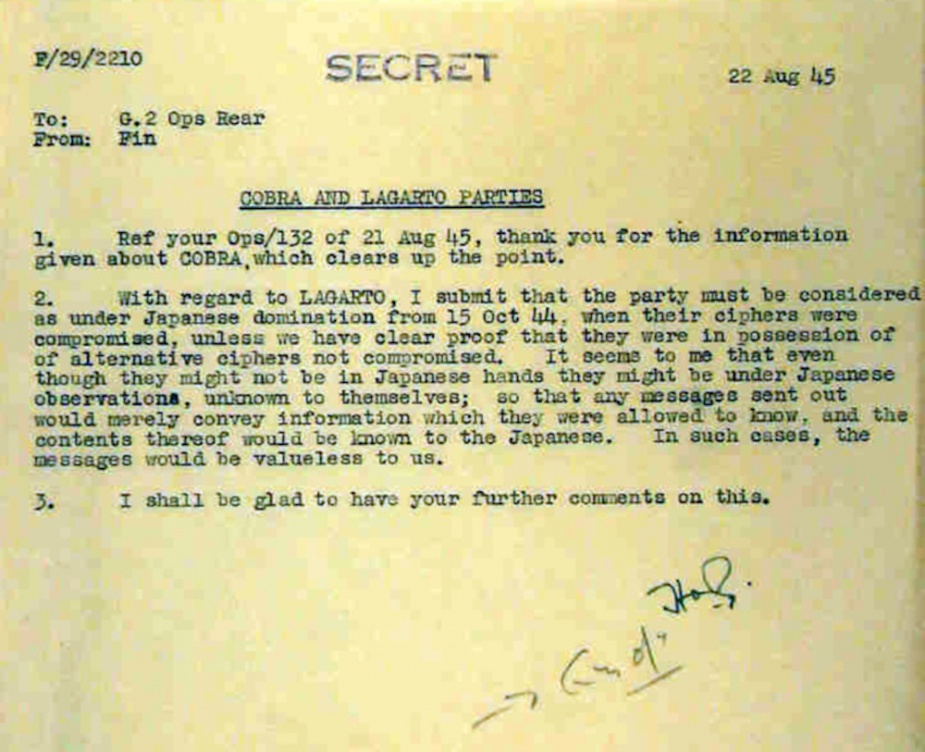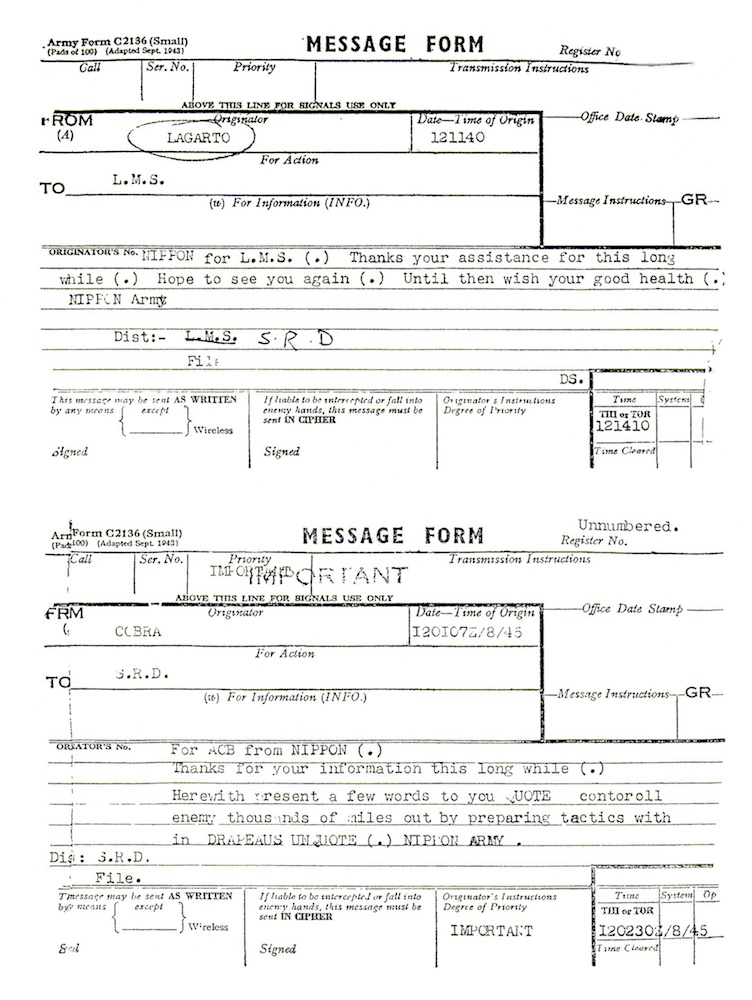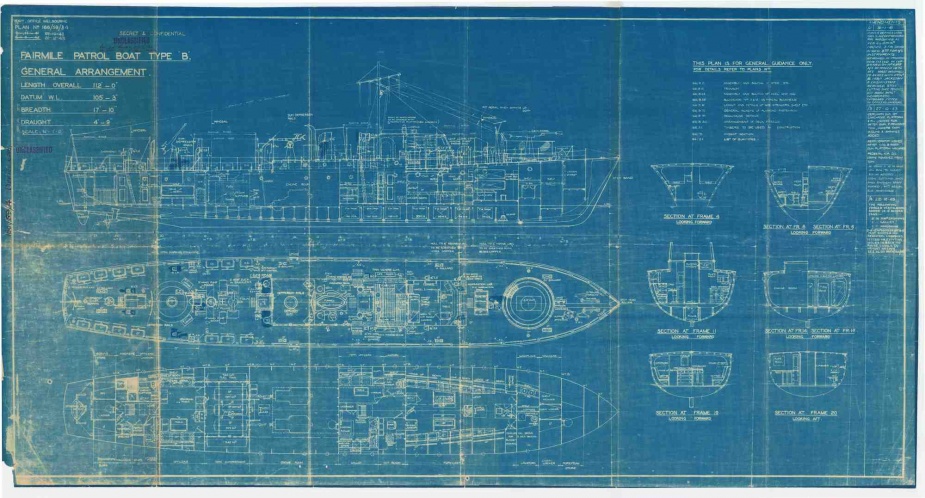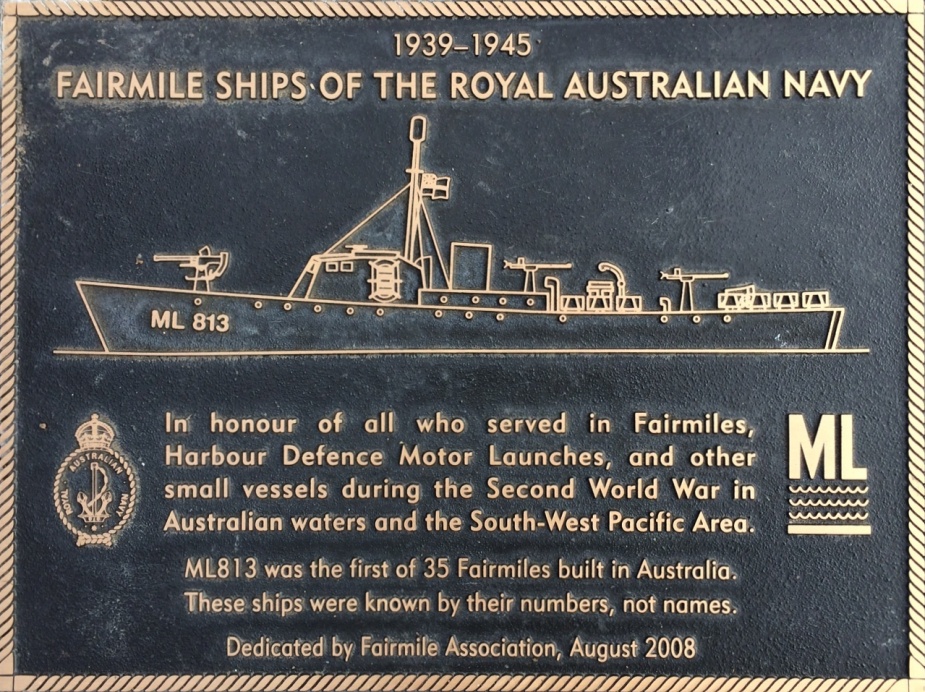ML 814
| Type |
Fairmile 'B' Type Motor Launch |
|---|---|
| Pennant |
ML814 |
| Builder |
Lars Halvorsen Sons, Pty Ltd, Ryde, NSW |
| Laid Down |
15 April 1942 |
| Commissioned |
1 January 1943 |
| Decommissioned |
12 October 1945 |
| Dimensions & Displacement | |
| Displacement | 75 tons |
| Length | 112 feet |
| Beam | 17 feet 10 inches |
| Draught | 4 feet 9 inches |
| Performance | |
| Speed | 20 knots |
| Range | 840 miles at 12 knots |
| Complement | |
| Crew | 17-20 |
| Propulsion | |
| Machinery | Twin Hall Scott Defender petrol engines, 650 HP each, twin screws |
| Armament | |
| Guns |
|
| Other Armament |
|
| Awards | |
| Battle Honours | |
Fairmile motor launches were small, fast, highly manoeuvrable, lightly armed ships designed in the United Kingdom. They were originally intended to be used for coastal anti-submarine and convoy protection duties but soon proved to be vessels capable of much broader operational tasking.
In April 1941 the Royal Australian Navy (RAN) recognised the need for a vessel which could be built locally and used in the littoral waters of Australia, New Guinea, the Dutch East Indies and their surrounding islands. On 5 January 1942 the War Cabinet gave approval to construct Fairmiles in Australia, and between November 1942 and April 1944, 35 vessels were commissioned into RAN service.
ML 814 was the second of the Fairmiles to be constructed in Australia. She commissioned on 1 January 1943 under the command of Lieutenant Gilbert R Kennedy, RANVR, a veteran of small ship actions fought against German E boats in the English Channel while serving with the Royal Navy.
The launching of 814 at Halvorsen's yard in Sydney is said to have caused Kennedy some disquiet, for he noticed a woman on board his new command as she took to the water. Kennedy was apparently reminded of the then superstition among sailors that it was considered a bad omen to have females onboard.
Appointed as Kennedy's First Lieutenant was Lieutenant Bernard Page Western (Chips) Wood, RANVR, while Sub Lieutenant Marsden (Tony) Hordern, RANVR, who joined the ship in February 1943 from the minesweeper Abraham Crijnssen, completed the wardroom complement.
Unlike other Fairmiles that were being brought into service, 814 was painted in a distinctive zig-zag disruptive camouflage pattern with hues of white, light blue and green being used to break up her appearance. This colour scheme was later determined to be impractical to maintain and in time it reverted to the normal plain grey livery found on most other RAN vessels.
Living conditions in Fairmiles were spartan. There was a small wardroom which the three Commissioned Officers shared, a cabin for two Petty Officers (normally the Coxswain and Petty Officer motor mechanic) and a small mess deck which accommodated twelve ratings. There were no showers and just two small hand pumped toilets. As the complement sometimes varied between 17 and 20, additional crew were faced with either sleeping on deck or adopting what was known as a 'hot bunking' routine in which they took turns sharing a bunk with a shipmate who was on watch. For the ratings all activities such as sleeping, eating, relaxing, letter writing, studying, etc, took place in the mess deck.
Generally there was no trained cook assigned to the Fairmiles and these duties were shared among the crew who took turns preparing meals on a small kerosene stove in the galley. Some Fairmile crews were fortunate in having one sailor who was both a good cook and who was willing to take on the job permanently. ML 814 was one such ship.
Following 814's commissioning, Kennedy and his crew immediately turned their attention to working the ship up. This involved a period at sea off the east coast of Australia during which the crew conducted drills and got to know their ship's strengths and weaknesses. It also coincided with a period of increased Japanese submarine activity along the eastern sea board. Twenty one attacks were made on merchant ships in the first six months of 1943 resulting in eleven sinkings including the Australian hospital ship Centaur.
On 18 February 1943, 814 sailed from Sydney for Brisbane where she arrived two days later. She remained in Brisbane waters conducting engine trials until early May, at one point losing her hull mounted Asdic dome while taking avoiding action to pass clear of the SS Buranda in the Brisbane Channel. A new dome was subsequently fitted and a formal inquiry was held into the loss of this expensive and highly secretive piece of equipment.
Not long after the inquiry into the loss, Kennedy was posted as the First Lieutenant of the corvette HMAS Inverell (I). He was replaced by Lieutenant Charles C Skarratt, RANVR; however, within a week of his arrival, he too was posted. Lieutenant RR (Reg) Lewis, RANVR - who like Skarratt and Kennedy had seen action with the Royal Navy in the English Channel, was subsequently appointed in command. In mid-May 1943 ML 814 received orders to sail for Darwin via Townsville, Cairns and Thursday Island.
Joining a north-bound convoy assembling near Cape Moreton, 814 was taken in tow by a United States (US) Liberty ship for the passage to Townsville. This was to save wear and tear on her engines which required a substantial service every 500 hours. After a two day passage, punctuated by rough weather and several parting hawsers, the tow was abandoned and 814 made her way independently through the Whitsunday Passage to Townsville. On 14 May she continued her voyage north, again under tow, astern of the SS Cardross. This time the passage was incident free and the two vessels parted company at Thursday Island. ML 814 proceeded to Darwin independently arriving there on Sunday 23 May.
Although new to the area, 814 was immediately put to work. On 1 June she left Darwin to protect the American ship Admiral Halstead while she was unloading supplies and aviation gasoline at Millingimbi, an RAAF advanced operational base on the north east coast of Arnhem Land. The outpost was home to Spitfire fighter aircraft, 350 RAAF personnel and around 600 Aborigines. It was also within easy striking distance of the Japanese and had previously been bombed by enemy medium range bombers.
The trip to Millingimbi was memorable for some of the worst weather yet experienced by the Fairmile crew. For 12 hours 814 pounded into heavy seas and many of her men succumbed to seasickness. To add to their misery, the deck planking on the forward upper deck opened up and water poured through, soaking those trying to get some sleep below.
This eventuality had been foreseen by the boat builder Harold Halvorsen during the ship's construction. He had urged the Navy to use Oregon for planking on the Fairmiles but his advice was ignored and hoop pine was used instead. It was a problem that many other Fairmile crews were to endure in similar conditions.
ML 814 took 34 hours to make its way though the heavy weather and poorly chartered waters to her destination. On arrival she refuelled then, after completing her assignment, began the return voyage to Darwin. In contrast to the outward leg, this took only 22.5 hours.
ML 814's next task was to assist the night passage of a convoy through the Clarence Strait. During peace time, this stretch of water was illuminated by navigational buoys, however, as a wartime security measure they were now lit only when considered absolutely necessary. Lewis and his crew were required to find and light one of these marker buoys with the assistance of a reef Pilot. The night was particularly dark with mist rising from the sea and in spite of their best efforts; the buoy could not be located. It was then that one of 814's lookouts reported a flashing light on an unexpected bearing. The Pilot checked his charts and determined that the light was originating from a particularly rocky section of Melville Island. Concerns over the origin of this light led to naval authorities in Darwin ordering the convoy to anchor overnight. It completed its passage in daylight the following day.
In late June, 814 was given an air-sea rescue task off the Japanese occupied Island of Selaru in the Tanimbar Group, some 350 miles north of Darwin. A flight of Vultee Vengeance and Beaufighter aircraft had been ordered to attack an air strip under construction on the island and 814 was pre-positioned nearby to recover any Allied airmen who might be downed during the operation. Deep in Japanese controlled waters, the crew waited anxiously while the raid took place before receiving orders to return to Darwin.
During the return voyage a submarine periscope was sighted astern of the Fairmile and was seen to be closing on a steady bearing. The alarm was sounded and the crew raced to action stations, not knowing whether the submarine was friend or foe. Moments later the submarine surfaced and a visual challenge was made by 814 using flashing light. To their great relief the submarine identified itself as an American. Japanese submarines had been detected in these waters and if the Australians encountered one of these fast and well armed vessels the outcome could have been disastrous for them.
While in Darwin between missions the crew of 814 experienced first hand the Japanese air raids which had caused so much damage since February 1942. When the air raid warning was given, 814 would proceed to sea and take up a pre-determined station, standing by to go to the assistance of any downed Allied airmen. It was during once such raid on 28 June that a near miss slightly wounded the First Lieutenant, 'Chips' Wood.
On 9 July, ML 814 left Darwin to escort the steamer Alagna, to the Drysdale Mission at Napier Broome Bay in Western Australia. Arriving there two days later they were faced with the problem of unloading Alagna's cargo of heavy equipment, motor vehicles and thousands of gallons of aviation gasoline stored in drums. There were no wharves or port facilities at the mission and 814's crew set about improvising a ferry service using an old lugger and Alagna's lifeboats. Two days later, after much hard work, the cargo was safely ashore and 814 returned to Darwin.
Operation LAGARTO/MOSQUITO
On the morning of 26 July 1943, Lieutenant Lewis and Lieutenant Charles AJ Inman, RANVR, the Commanding Officer of ML 815, were ordered to report to the Operations Office ashore. There they were briefed to prepare their ships to proceed to Japanese occupied Timor in support of Operation LAGARTO. The Naval component of the mission was named Operation MOSQUITO and required the two Fairmiles to slip deep into enemy controlled waters and re-supply the Portolizard guerrilla group. They were also to insert an Australian Army signaller (Sergeant AJ (Jim) Ellwood) and evacuate approximately 70 civilian refugees who had attached themselves to the group, and who were now impeding its effectiveness.
The MOSQUITO operation was among the first of a number of clandestine activities in which the RAN Fairmiles and Harbour Defence Motor Launches (HDML) were involved supporting the secretive Allied Intelligence Bureau (AIB) and Services Reconnaissance Department (SRD).
There was little time to prepare for the impending operation which called for a landing on Timor within three days. The Fairmile's depth charges were unloaded to provide extra deck space and a special launching ramp was constructed over the stern of each of the two MLs to enable the rapid deployment of a large wooden and canvas landing craft. These craft were to be pushed into the water to seaward of Timor's surf and rowed inshore to effect the landing of stores and provisions. They would then return to the Fairmiles with the civilian evacuees and be taken in tow for the return voyage to Darwin.
It was also suggested that the two MLs should fly Japanese naval ensigns to improve their chances should they be detected by enemy air or sea patrols. This idea was immediately rejected by the ship's officers in spite of specially made flags being delivered to them by an Intelligence Officer prior to sailing. Remarkably the flag issued to 814, which was unceremoniously stowed in the ship's potato locker by her signalman, D'Arcy Kelly, was retrieved by Sub-Lieutenant Hordern months later. Kept by him, it was then presented to the Australian War Memorial by Hordern, Wood, Kelly and several other veterans from the MOSQUITO operation in 1994.
Two Beaufighters from No 31 Squadron, RAAF, were also assigned in support of the mission; providing a relay of cover, in air space dangerously close to Japanese fighter bases in Timor.
Final preparations were made at the secret AIB base located about 18 miles from Darwin on the east arm of the harbour. Here the landing craft was loaded in 814 and members of the SRD, the army's 'cloak-and-dagger' men, embarked along with a specialist navigator, Lieutenant WB Hill, RANVR, and a Portuguese navigational Pilot named Baltazar.
At 22:00 on 27 July, the two Fairmiles got underway and set course for Melville Island. The following morning they arrived in Kings Cove, St Asaph Bay where they rendezvoused with the tender, HMAS Terka, to take on additional fuel and water. Later that afternoon they continued their passage bound for a reference point on the southern coast of Timor close to the mouth of the Dilor River. In the early hours of 29 July, radio silence was broken when a signal was received recalling both vessels to their staging position. No reason was given and by 19:00 that evening they were again in St Asaph Bay refuelling. The ships remained there for two days awaiting further orders before they were eventually recalled to Darwin. The mission had been postponed at the request of an operative in Timor who was concerned about the presence of Japanese forces in the landing area. The operation was soon rescheduled to take place on 3 August.
The two MLs re-embarked their cargo of equipment and personnel and at 22:31 on Monday 2 August set out again, this time refuelling at Snake Bay, Melville Island. At 17:30 the next day they proceeded on a north westerly course for the position on the south coast of Timor. The night passed without incident and early the next morning they were joined by their RAAF Beaufighter escort which maintained a presence until late that afternoon.
Just after nightfall the two Fairmiles closed the rendezvous position where they observed three small fires on the beach. This was followed by the reception of a faint blue recognition signal from the shore. Baltazar confirmed that they had arrived at the correct location on the chart and the Australians quickly set about lowering their landing craft.
With their vessels loaded with provisions, the crews of 814 and 815 headed through the surf towards the shore where they were eagerly met by the guerrilla force. 'Chips' Wood commanded the first landing party from 814 and was soon busily overseeing the insertion of Sgt Ellwood, the unloading of stores and the embarkation of the first load of refugees who had begun to emerge from the tree line beyond the beach. After about 15 minutes he returned to 814 where Hordern relieved him to oversee the subsequent landing parties.
Met by wild looking figures on the beach, Hordern immediately began embarking the next load of refugees, however, the small landing craft quickly filled and for safety's sake the embarkation was halted. As the crew of 814 were about to leave Hordern glanced along the beach and noticed an elderly man dressed in a white suit and Panama hat standing in the shallows. He made no attempt to seek refuge for himself and appeared content to see his fellow countrymen and women carried to safety. Hordern immediately waded toward the lone figure and dragged him back through the surf and into the landing craft before jumping in himself. As the boat made its way back to the relative safety of 814 the elderly man took something from his hand and gave it to Hordern in gratitude, instructing him that should he 'ever go to Portugal, show this'. The gift that Hordern received was an ancestral silver heraldic ring inlaid with the armorial bearings of the man's family - a rampant gold lion on a field of jade green. As with the Japanese ensign, this too survived the war.
After several further boat trips the two Fairmiles took their landing craft in tow at 22:50 and shaped course for Darwin. The return voyage was made at a brisk 17 knots with the aim of putting as much distance as possible between the Australian ships and any Japanese patrols before daybreak. Dawn the following day revealed the desperate state of the refugees embarked in 814. Many were suffering from malnutrition, wounds and tropical ulcers, and nearly all of them were seasick. The crew provided what assistance they could but it was a great relief to all onboard when they finally secured alongside Darwin at 11:30 on 5 August. Here, ambulances and medical attendants transferred 814's human cargo to hospital for treatment and observation.
For this operation, MLs 814 and 815 received the following congratulatory message from the acting Portuguese Governor in Timor:
"Profoundly grateful to Sea Land and Air Forces Darwin for Gallant and splendidly successful rescue my Nationals under extremely trying circumstances. We are yours to command for the duration to help against common enemy. Viva Australia. Viva os Aliados."
In contrast, the LAGARTO operatives ashore did not fair well. They were relentlessly hunted by Japanese patrols that exacted severe retribution on any Timorese found helping them. The group was finally ambushed and captured on 29 September along with their codes, ciphers, signal plans and other papers.
Following their capture, the men, including Ellwood, endured a sustained period of interrogation including torture. Ellwood, who was weak with hunger, pain and disease, later succumbed to his brutal mistreatment and was forced, under duress, to transmit bogus messages to the SRD in Australia purporting that the group was still at large and operational. These signals were accepted on face value by SRD Headquarters in Melbourne despite obvious indications that the group had been compromised. Consequently, further operations to Timor were planned by the SRD and ML 814 was again to be involved in them.
In the meantime, following the excitement of MOSQUITO, 814 settled down to the comparatively dull but essential routine of convoy duties, anti-submarine sweeps, exercising and escorting Allied submarines into Darwin. Allied submarines were not permitted to approach Australian harbours without an appropriate escort which normally rendezvoused with them well out of sight of land where a challenge was made by visual signal. On receipt of the correct reply the Port War Signal Station would be advised of the impending arrival, and the submarine would be escorted into harbour. This duty was one well suited to the Fairmiles as they had sufficient speed to match US submarines on the surface.
On 6 August 1943 the 8000 ton steam ship Macumba was attacked off the Arnhem Land coast by Japanese float planes. Her escort, the corvette HMAS Cootamundra, scored a hit on one of the attacking aircraft, shooting off a float, but a well aimed bomb struck Macumba's engine room killing and wounding many of her crew. The ship soon foundered, leaving Cootamundra to rescue survivors. ML 814 was ordered to proceed at top speed to rendezvous with Cootamundra where she transferred a doctor onboard to provide further assistance. The ML then escorted the corvette back to Darwin where the dazed survivors were landed and taken to hospital.
At the end of August, 814 entered Darwin's floating dock for a brief maintenance period before resuming patrol and escort duties. Shortly afterwards, Lieutenant Wood was posted ashore and Hordern was appointed as First Lieutenant. Joining as 814's new third officer was 19 year-old Midshipman John Dowey, RANR.
The onset of Darwin's wet season in late October presented new challenges for 814's crew. Every day it rained heavily and when it cleared, steam rose from her wooden decks, making living conditions inside the ship almost unbearable. Mildew formed throughout the vessel which soon became a haven for cockroaches and bugs. This became the catalyst for an increase in tropical maladies such as tinea and other skin complaints. The retrofitting of upper deck awnings to the Fairmiles that later deployed to Darwin helped to improve conditions a little, but for both 814 and 815 they enjoyed no such respite from Darwin's unrelenting tropical weather.
In mid-January 1944 Hordern was diagnosed with vitamin B deficiency which affected both his vision and balance and ultimately resulted in him being posted to Sydney where he spent time in hospital recovering from incipient beri beri. Consequently, the young Dowey soon found himself appointed as 814's new First Lieutenant.
Operation COBRA/BULLDOZER
Towards the end of January, Lewis received orders that 814 was to again make the dangerous passage to enemy occupied Timor in support of another SRD operation, known as COBRA. The naval component of the operation was subsequently designated BULLDOZER and was scheduled for 27 January. As with the LAGARTO/MOSQUITO operation, it involved carrying and inserting SRD and 'Z' Special Unit operatives into Timor. This time, however, 814 would sail alone. There was little time to prepare for the mission which again called for the carriage of special landing craft and the construction of a temporary cradle and launching ramp over the stern. Confidential books were landed prior to sailing as a safeguard against capture, as were several depth charges to make room for additional fuel drums. To assist with the passage Lieutenant E Butler, RANR (S) joined 814 as a specialist navigator along with Telegraphist BE Wales who assisted in maintaining the necessary 24 hour radio watch throughout the mission.
The COBRA landing party was embarked at Shell Island at 20:00 on the evening of 27 January. Captain JL Chipper, AIF, was in overall charge of the insertion of the party which comprised Captain JR Cashman, AIF, 'Z' Special Unit, Lieutenant EJ Liversidge, AIF, 'Z' Special Unit and three Portuguese nationals, Sergeant Paulo da Silva, Sergeant Cosme Soares and Sergeant Sancho da Silva. With the operatives on board, 814 sailed from Darwin at 23:00 for St Asaph Bay, Melville Island, where she refuelled from the tender HMAS Coolebar the following afternoon. At 19:20 on 28 January, 814 cleared St Asaph Bay and set course for her destination, a point near the western entrance of the Dara Bai River on Timor.
From the outset, the voyage was hampered by rough weather and poor visibility and at one point the RAN and AIF officers considered whether the mission should proceed. Electing to press on, the difficult passage continued until gradually the weather abated sufficiently for accurate navigational sun sightings to be taken. In spite of the weather, the RAAF managed to provide air cover for the lone Fairmile throughout the following day. Meanwhile, below decks many of the crew were struggling with seasickness while again dealing with the problem of sea water pouring through 814's inadequate decking.
Notwithstanding the difficult voyage, Lewis, ably assisted by Butler, made an accurate landfall on Timor and 814 was soon quickly proceeding to her rendezvous position. As she made her approach, numerous shore lights were observed and the ML issued challenges by flashing light, however, no reply was forthcoming. Cautiously, Lewis continued on a southerly course and at 23:40 when it seemed likely that the party would have to be landed without assistance from the shore, the designated signal of three fires on the beach was observed. The Fairmile quickly anchored and, due to the confusion over identification signals, the now Sub Lieutenant Dowey was ordered to take Captain Chipper and a small landing party ashore to investigate. After landing some 200 yards to the south of the fires, Chipper was met by Timorese natives and after questioning them, was satisfied that everything appeared to be in order. Dowey and his sailors then returned to 814 to begin ferrying the guerrilla's stores and equipment ashore.
While the stores transfer was taking place, 240 gallons of fuel, which had been carried in drums on the Fairmile's deck, was transferred into her depleted fuel tanks in readiness for the return voyage. At 01:30 (30 January) Dowey returned with his crew and Chipper to 814 where the landing boat was recovered and a course set for the return voyage to Darwin. Unbeknown to the Fairmilers as they sped for home at 15 knots, the COBRA party they had landed had less than an hour before they, as with the LAGARTO group before them, would be captured by the Japanese.
The COBRA operation was doomed from the outset when details were communicated by SRD HQ in Melbourne to the already compromised LAGARTO group. This enabled the Japanese to make elaborate arrangements to apprehend them shortly after their insertion. Ellwood, who had been taken by the Japanese to the site of the ambush, made a valiant attempt to warn the COBRA party of their impending capture when he overpowered his guard and escaped. The guard, however, raised the alarm and Ellwood, weak with beri beri, was soon recaptured then beaten, bound and left without food or drink in the open for 48 hours. He was then returned to Dilli where he was put on a starvation diet which brought on a return bout of malaria and dysentery. It was here that he learned that the COBRA party had been captured.
ML 814 arrived safely back at Shell Island at 10:35 on 31 January where they disembarked Chipper who had returned with them, before securing alongside the main jetty in Darwin Harbour. Both Butler and Dowey were singled out for special mention by 814's Commanding Officer in his post operation report for their part in the execution of BULLDOZER.
Shortly after BULLDOZER many of 814's crew proceeded on leave and posting. Among those who earned a well earned relief was Lieutenant Lewis who handed over his command to Lieutenant AC McAllister, RANVR.
Following twelve months in tropical conditions, 814 was is urgent need of a refit. Her Hall Scott engines required overhauling as did her gear boxes. Major maintenance of Fairmiles in northern waters was largely untried and with a growing list of defects and alterations recommended by Fairmile Commanding Officers, 814's refit became somewhat of test case. The Naval Board decreed that Darwin, with a base staff consisting of engineers, shipwrights and other technical specialists would carry out the task on the slipway at Frances Bay in Darwin Harbour. If successful it would pave the way for New Guinea-based motor launches to use the facilities and avoid the long haul to Brisbane or Sydney for major refits.
On 28 March, 814 went onto the slipway. Unfortunately, due to limited wartime facilities and inadequate numbers of skilled maintenance personnel, the refit proved to be beyond Darwin's base staff's capability and it was not until 11 June that 814 re-entered the water. Conditions for those working on the vessel while on the slip were extreme. Again, the absence of awnings meant that the men were completely exposed to Darwin's harsh tropical climate while working on the upper decks, while those working between decks and in her engine room had to endure temperatures well in excess of 100 degrees Fahrenheit.
This prompted the Commanding Officer of 815, (Lieutenant JDC Wood, RANVR), which was the next vessel scheduled to take to the slip, to forward a strong recommendation that her refit be carried out in a well-equipped yard, preferably in a port with a more temperate climate. It transpired that on 19 August the complements of 814 and 815 were exchanged with the exception of motor mechanics. The reason for the exchange is unclear but on 7 September, 815, now under the command of McAllister, sailed for Fremantle and refit via Onslow and Geraldton. Command of 814 passed briefly to Lieutenant BO Wallace, RANVR, and then to Lieutenant AG Fry, RANVR.
During the period that 814 was undergoing refit, SRD HQ continued to plan and execute further clandestine operations around Timor. ML 429 (Lieutenant HF Wadds, DSC* RANVR), another Fairmile, was directed to operate in support of Operation ADDER in May. However, following a close encounter with a Japanese encampment and after running into difficulties off Timor and losing her landing craft, the mission was aborted. A further attempt to insert the SRD's ADDER party was again aborted when 429 was spotted by an enemy aircraft. In mid August, the operation was ordered to proceed in spite of protests by the three senior officers involved, who believed that to continue with the same operational plan would be reckless and put lives at risk. Finally, after two further attempts, the ADDER party was successfully landed on the northern tip of Timor on 21 August.
Three weeks later SRD HQ had received no contact from the ADDER party, raising concerns for their safety. Consequently another operation to Timor was ordered in an attempt to locate them. MLs 814 and 807 (Lieutenant EHC Couchman, RANVR), were selected for this mission.
Unlike previous missions, which had been routed via Melville Island, it was decided that a direct passage would be made on this occasion with additional fuel taken on in Darwin. After embarking their landing craft, fuel and stores and having practiced several mock landings with the awkward landing craft near Talc Head, the two ships were ready to proceed. At the request of Fry, Sub-Lieutenant TWJ Vear, RANR, 429's First Lieutenant, joined 814 because of his previous experience in the ADDER operations.
The two Fairmiles sailed from Darwin on 18 September. Both vessels were initially operating on only one engine to conserve fuel, but consumption was still high at 20 gallons per hour. By the following day they had transferred all the fuel from the eleven 44 gallon drums carried on their upper decks into their main tanks and jettisoned the empty ones, filled with sea water, over the side. Once again a Beaufighter escort was provided by the RAAF which maintained a low-level patrol around the two vessels as they continued their passage. Land was sighted at 17:30 on 19 September and by 21:30 both vessels were patrolling approximately 200-300 yards offshore where they investigated several small lights which were later identified as camp fires.
At 21:45 when leaving the vicinity in a south westerly direction a large and very bright fire was observed to be lit on the beach about 400 yards away. As there was no sign of enemy activity, 814 closed to investigate further. It was clear that the fire had been deliberately lit and as if to support this, a man was observed to be standing near the fire looking at the Fairmile as it passed by. He made no attempt to do anything and Fry, conscious of the risk of an ambush, cleared the area and resumed the south westerly patrol.
Disturbingly, visual contact with 807 was lost shortly afterwards in spite of the clear skies and good visibility, leaving 814 to continue her patrol alone. Two more large fires were later observed, however, there was no sign of deliberate signalling from operatives ashore. The sweep concluded at 23:45 when a course was set for a pre-determined rendezvous with 807, some 80 miles off the Timor coast. 807 failed to make the daylight rendezvous leaving 814 no alternative but to continue the return passage to Snake Bay independently. Two Beaufighters joined 814 at 06:50 on the morning of 20 September and one of these was detached to search for the missing 807.
814 entered Snake Bay that evening where she remained at anchor overnight refuelling during the forenoon of 21 September. At 12:00 the crew of 814 were relieved to see 807 arrive safely and she too took on fuel for the last leg of the voyage to Darwin. Both vessels completed the passage without further incident the following day. There was no immediate explanation for the various fires that the Fairmiles had observed on the beaches of Timor and on 10 November 1944 the members of the ADDER party were officially posted as 'Missing in Action'.
Epilogue to SRD operations in Timor
It would be years before the Fairmile crews who took part in the MOSQUITO, BULLDOZER and ADDER operations learned of the fate of the SRD men they had come to know and support in operations. By November 1944 the AIB's advanced operating base in Darwin, known as the Lugger Maintenance Section (LMS), had become suspicious that both the LAGARTO and COBRA parties in Timor may have been compromised. Without informing SRD HQ, or the suspect Timor parties, it was arranged for Captain A.D. Stevenson and Sergeant R.G. Dawson, both of 'Z' Special Unit, and Celestino dos Anjos, a Timorese guide, to be parachuted into Timor two days ahead of a proposed supply drop to LAGARTO. No resupply was ever intended, but on the night of 29-30 June 1945, Stevenson's party, operating under the codename SUNLAG, landed safely in an area close to the signalled drop zone and made preparations to observe any Japanese intervention. It was here that Stevenson saw Ellwood of the LAGARTO party approach under armed guard carrying a signalling lamp. The AIB now had proof that LAGARTO was in enemy hands and that Ellwood was being forced to make the bogus transmissions. Due to problems with their radio set, Dawson was unable to inform Darwin of the compromise until 3 July. In the meantime, yet another party had been inserted by parachute.
This party known as SUNCOB comprised Captain P Wynne and Corporal JB Lawrence, both AIF and 'Z' Special Unit men. Both were captured and tortured by the Japanese who soon learned of the existence of the SUNLAG party and immediately committed a large force to hunt it down. The rescue of SUNLAG was now paramount and although Stevenson and Dawson were competent bushmen, the LMS considered it only a matter of time before they were captured.
On 15 July arrangements were made to extract them using the captured Japanese trawler, Krait, which was to meet them close to the mouth of the Dilor River. Strong winds, poor visibility and other contributing factors resulted in this attempt being aborted and a further extraction, codenamed BRIM, was arranged. This time Harbour Defence Motor Launch (HDML) 1324 under the command of Lieutenant RG Evans, RANR, was the rescue vessel and the operatives, who were now in a very poor physical state, were finally extracted on 5 August. ML 1324 arrived back in Darwin on the evening of 6 August. Stevenson and Celestino survived the ordeal but Dawson, who was rushed to hospital on arrival in Darwin, died from kidney failure two days later.
A subsequent report concerning the SRD's operations in Timor stated inter alia 'The LAGARTO Operation has no redeeming feature. It is a story of hardship, death, torture, humiliation and degradation meted out by a ruthless enemy. It is a story of colossal waste, since all subsequent operations in the area for a period of two years depended on the assumption of LAGARTO's freedom. It produced nothing whatever of value and neither did the subsequent operations. To this failure can be ascribed the wretched deaths of 9 Australians, some Portuguese and scores of loyal natives. Even the Japanese must have despised the gross inefficiency and criminal negligence with which it was conducted'.
This final statement is supported by the last signals received by the SRD on the LAGARTO and COBRA frequencies in which the Japanese openly mocked them.
Ellwood and several other SRD operatives survived captivity and were repatriated to Australia following the cessation of hostilities with Japan. The final indignity for them came at the hastily arranged War Crimes Trials at Darwin in March 1946. They were not called upon to testify as witnesses against their captors, nor were their written statements admitted as evidence, as they were determined to be unauthenticated copies. Consequently the two main perpetrators of their mistreatment escaped with an acquittal and three months imprisonment respectively.
ML 814 continued to operate from Darwin performing anti-submarine patrols, boom defence patrols and escort duties until 19 May 1945 when she sailed for Brisbane calling at Cairns, Townsville and Gladstone en route. She paid off at the small craft base in Brisbane on 12 October 1945 having covered an impressive 30,154 nautical miles during her wartime career. Her hull was sold for disposal in Brisbane on 30 August 1947 for ₤200.
Commanding Officers of ML 814
- Lieutenant GR Kennedy, RANVR
- Lieutenant CC Skarratt, RANVR
- Lieutenant RR Lewis, RANVR
- Lieutenant AC McAllister, RANVR
- Lieutenant BO Wallace, RANVR
- Lieutenant AG Fry, RANVR
- Lieutenant BR Bayly, RANVR
References and further reading
- Special thanks to LCDR Marsden Hordern, VRD, RANR, (Ret'd) and Sub Lieutenant John Dowey, RANR, (Ret'd) for permission to use images from their personal collections and draw on their memoirs and memories.
- 'A Merciful Journey, Recollections of a World War II Patrol Boat Man', Marsden Hordern, The Miegunyah Press, 2005.
- 'Fairmile Ships of the Royal Australian Navy Volumes I & II', The Fairmile Association, Australian Military History Publications, 2005.
- 'Report on Operation BULLDOZER, 27-31 January 1944' by Commanding Officer HMAML 814, 1 February 1944.
- 'Report on COBRA Landing, Department of Army', 2 February 1944.
- 'Special and Secret', Time Life Books, 1990.
- 'Operational Report on LAGARTO' by VX67548 CAPT AJ Ellwood.
- 'Report on COBRA Party' by VX109980 CAPT JR Cashman.
- 'Volumes of History of Inter Allied Services Department and Special Operations - Australia. Organisational Copy No. 1, 1945'
Australian Archives: CRS A3270 Volume II. - 'Navy Lists 1939-1945', Royal Australian Navy.

